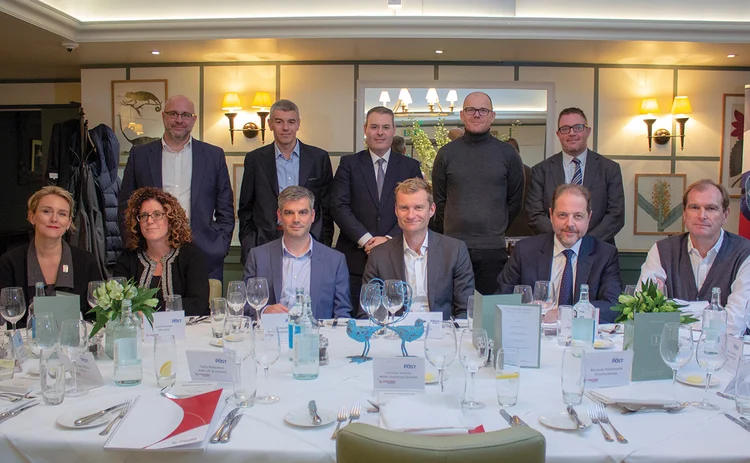
This article was paid for by a contributing third party.

Roundtable: Getting over the back office blockade

Are insurers actually being held back by their legacy systems?
Turlough O’Brien: I’d say undoubtedly. We’ve got platforms that are older than I am. If we take examples from any other industry, that just wouldn’t be financially viable. So, yes, insurers are being held back by legacy.
But it varies. We’ve got territories where we have a lot less legacy. In the UK, which is our heartland and where we have the majority of our business, we have the full breadth of legacy straight through to very cutting-edge digital propositions, app-based, mobile propositions.
Stephanie Smith: One of the reasons why we have been laggards in relation to other industries is because we probably haven’t appreciated the need to invest and move on at pace. As someone who has come from a non-insurance background, my view is that’s primarily because insurers have been what I would describe as fat and lazy.
We know how to work the numbers and consequently we’re able to ensure year-on-year that we do quite well and there’s been no burning platform. But increasingly, it’s becoming much more self-evident that there is a burning platform and, therefore, we have to pull our finger out.
Juliet Sharman: Legacy issues build up as you combine organisations through mergers and acquisition. When you’re a small company and you’re running on your systems the way that you do and the business processes work for you, it’s not so much a problem.
When you start to stick them together with Sellotape and bits of sticky-back plastic, it all gets a bit Blue Peter and that really becomes a problem.
Peter Howard: There’s a two-tier system running here, isn’t there? If you look at what happened to personal lines over the last decade, I would argue that they have embraced technology and they have moved at pace to completely revolutionise the industry, almost to the extent that the old traditional high-street broker no longer exists.
Commercial insurance on the other hand – they’re going through the first stages of grief in terms of their transformation. They remain in anger, denial and bargaining.
Has personal lines really got it sorted, or is the back-end still lagging behind the front-end?
Nick Hansford: The challenge is traditionally your direct personal lines are probably on different systems. You can do the pretty stuff at the front and you can do some magic in the middle to glue them together. But unless you go through the heart surgery of working it out and putting something else in, there’s always going to be constraint there.
The issue you get is the cost and the effort of doing that. Application programme interfaces have been really good for us as I don’t replace legacy but I can try and put an API round that functionality, and I can serve it out. The actual engineering of doing that can be quite tricky and it’s not perfect.
There’s a little bit of smoke and mirrors in there, because to us it’s about what the customer sees. There is a bit of pain going on underneath it and we bear the brunt, but you have to weigh that up against the cost of doing that big heart surgery.
What about automation? Does it present any challenges?
Charlie Blackburn: We had a legacy part of our business and our new platform does 20 times the volume. We have one underwriter doing the same volume as 20 underwriters.
It’s not the legacy technology; it’s the fact that it’s manually underwritten with poor workflow management, lack of automation of rating, re-keying, and all this stuff.
It’s as simple as: is your end-to-end process fully automated or not, and is that a competitive advantage?
Well, clearly if I need 20 times the number of people – it’s not exactly the same, because the policies are a bit more complex and we need more manual underwriting for our high-net-worth book than our mid-worth book – but there’s no question that the automation that was meant to be done in the 1990s is probably a good thing to crack on with.
O’Brien: It’s about how you position it to reset expectation. It offers an opportunity to broaden your propositions and to look at new products that, potentially, require the underwriting expertise that you would have, effectively automated.
There’s always resistance. But there’s a key opportunity in how you position it really.
Howard: In our businesses, we’ve got lots of smart clever people and we’ve got content and, historically, the content has always been in document, so it’s like the Rime of the Ancient Mariner: “Water, water everywhere, nor any drop to drink.” It’s not digitised.
The Lloyd’s Blueprint and things like Placing Platform Ltd ,and any kind of online system that is harvesting ones and zeroes, but not producing documents, creates this dataset, which will drive underwriting decisions. You’ll have an engineer’s probability curve for everything. As a consequence of that, those decisions will become almost binary.
It’s either in or it’s out. So, the speed of change in that area will be quite dramatic and that will probably be a good thing for consumers.
What’s the biggest driver of change: getting it right for the customer or balancing that up against the cost?
Riccardo Palombella: We are talking about being policy-centric rather than customer-centric, when what companies should want to achieve is becoming service-centric or customer service-centric.
Historically, the service branches in insurance have grown in parallel to the insurance itself and they are two completely different things and when you try to put them together – the service you want to provide and the product you want to sell to the same customer – it’s completely unachievable at the moment.
Normally you provide services through platforms and systems that are completely different from the one you use to sell the policies and this, of course, is not working at all.
How quickly does a system become a legacy system in today’s fast-paced technology race?
Smith: Part of the challenge is you’ve got to build in resilience going forward in everything you do and so APIs have helped a lot in that context.
But you’re always going to have a legacy and, whereas in the past we might have thought, ‘crikey, you need a project to sort the legacy out’, we’ve now realised it’s like painting the Forth Bridge: you never get to the end of it.
You’ve got to be smarter. We’re looking forward more in relation to creating the right environment and culture, so that we’re smarter with what we’re building going forward.
Christian Kitchen: We’re so used to project thinking, to decades of IT and technology projects. We start, we have overruns, we deliver it, and we wrap it up and move on to the next project. That’s why we have all of these legacy systems that are anchors on our corporate balance sheets and makes it hard to move away.
If you change your thinking towards your systems and you think about continuous integration, continuous deployment and development, and think about our technology ecosystems as things that we’re continuously refreshing and keeping evergreen, we won’t have this same problem for the next 10, 20, 30 years. But if we don’t make that determination, we’re sunk.
It’s only recently that we’ve had technologists coming into insurance and the passion around insurtech and this new sort of energy that we can do real meaningful things here. That’s what’s going to change it.
What is going to happen in the next 18 months that will force people to address legacy systems?
O’Brien: I don’t know about 18 months, but I’m an active participant in B3I, the blockchain initiative. It’s not going to be a risk event, it’s going to be capital and the super abundance of capital in global markets. The margins in insurance are comparatively high versus wafer-thin margins that companies like Amazon and Apple are accustomed to in their markets.
The blockchain technology will be an enabler to create a more efficient route for that capital. That will be the black swan event that will effectively change the landscape of insurance – probably not in the last 18 months though.
Smith: The whole operational resilience topic – the TSB event on its own clearly has created quite some interesting noise, and that’s suddenly making us think very carefully about what we do and how we do it.
Certainly, one of the reasons why I am quite nervous is because of the legacy we’ve got, it’s becoming increasingly harder to be confident that when your rate changes, they are going to be stable, and that you’ve thought of everything.
If I look at where my incidents occur, often they’re rooted in old legacy systems that we didn’t quite understand. It’s been hard to find people to answer questions on them. So, that is going to become even more of a topic and make us think more robustly about our legacy problem.
Adam Mitchell: It’s probably worth mentioning our old friend the General Data Protection Regulation. From our point of view, there was an expectation this was going to stimulate the market, that everyone was going to buy cyber policy and we’ve not seen that come through.
What we have found is, it’s made data sharing more challenging for us. Therefore, we’ve become more insular. There’s less of an inclination for us to go for a proof of concept with an insurtech because we’ve got more barriers to jump through.
What does good look like, and what benefits can it bring to the market?
Giuliano Altamura: You need to design things in an open way, in order to be able to address requirements that no one can see today, and design things to be flexible.
When an event or new requirements arrive, we must be able to adopt them quickly. If we design something that is flexible, of course, that makes it achievable.
Sharman: It is really about communication and collaboration with stakeholders. Because if it goes in the ‘too hard’ basket and then no one goes anywhere, and no one moves forward.
Carlo Nebuloni: Simplification is probably the main thing for me. We’re far too complex as an industry to, basically, reply to any challenge. What I see is that we will only move under the pressure from the regulator, so I’m dreaming, for once, of a regulatory challenge that can push the industry in the right direction.
Kitchen: Unequivocally, the most important thing that we can do to get to good is open standards across the industry. We need to be looking more towards banking.
We need to be looking at open APIs, and everyone here has said it today: if no one’s systems are uniquely competitive propositions, then let’s all get together and sort it as an industry.
Sponsored
Copyright Infopro Digital Limited. All rights reserved.
You may share this content using our article tools. Printing this content is for the sole use of the Authorised User (named subscriber), as outlined in our terms and conditions - https://www.infopro-insight.com/terms-conditions/insight-subscriptions/
If you would like to purchase additional rights please email info@postonline.co.uk
Copyright Infopro Digital Limited. All rights reserved.
You may share this content using our article tools. Copying this content is for the sole use of the Authorised User (named subscriber), as outlined in our terms and conditions - https://www.infopro-insight.com/terms-conditions/insight-subscriptions/
If you would like to purchase additional rights please email info@postonline.co.uk
